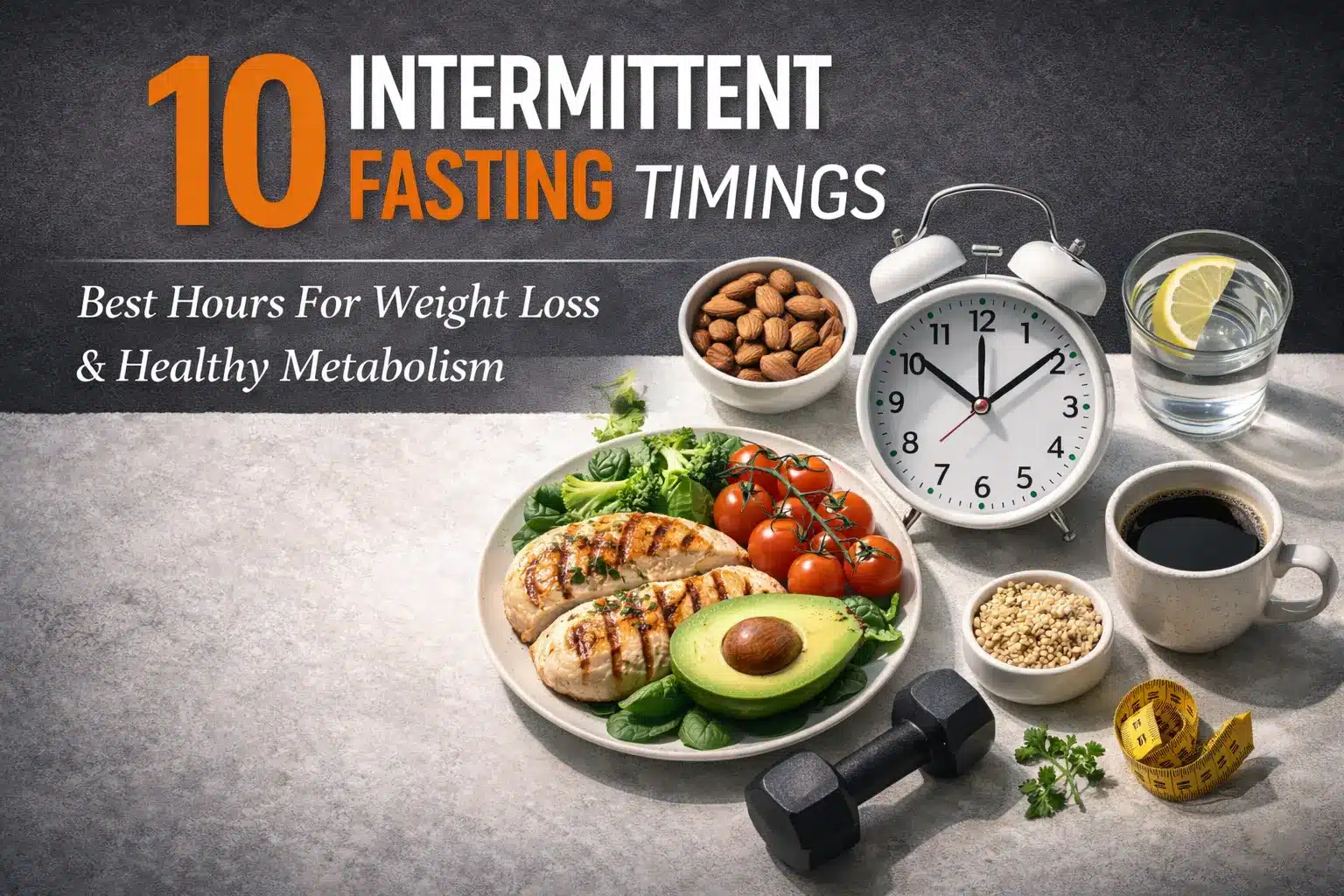What Is 18:6 Intermittent Fasting?
Out of various types of intermittent fasting, 18:6 intermittent fasting is a method of fasting (IF) where you fast for 18 hours a day, which may be called a fasting window, and eat during a 6-hour window. This type of fasting has become famous for its potential health benefits, including fast weight loss, increased focus, and lower inflammation.
Unlike other forms of IF, 18:6 focuses on a specific daily eating schedule, requiring you to fast for 18 hours and consume all your calories during a 6-hour eating window. During this time, you can have two full meals and a snack.
Research published in the New England Journal of Medicine and other studies shows that conditions like obesity, diabetes, cardiovascular disease, cancer, and neurological problems can all benefit from intermittent fasting.
When following 18:6, you can still eat a wide variety of foods, but focusing on healthy, nutrient-rich choices is essential to get the most benefit from this approach. 18:6 Intermittent fasting also requires drinking plenty of water and staying hydrated throughout the day to avoid dehydration and fatigue.
Intermittent fasting has emerged as a powerful approach to weight management and overall well-being, with various methods gaining popularity. Among these, the 18:6 Intermittent Fasting protocol stands out for its simplicity and effectiveness.
In this comprehensive guide, we’ll explore the intricacies of 18:6, from its stages and benefits to practical considerations, providing you with the knowledge to embark on a transformative health journey.

Difference Between Normal Fasting and 18:6 Intermittent Fasting
The most significant difference between regular and 18:6 intermittent fasting is that 18:6 consumes all of your calories within a 6-hour window. In contrast, with periodic fasting, you abstain from food entirely for a specific period.
Moreover, 18:6 intermittent fasting requires you to be very mindful of the timing of your meals and snacks, while regular fasting does not. 18/6 Intermittent fasting may be easier to maintain long-term since it allows you to have two full meals and a snack each day, while regular fasting may be more challenging to sustain over long periods.
In addition to the above, in the realm of 18:6 intermittent fasting, adopting the practice of skipping breakfast during the fasting window becomes a key strategy for optimizing the metabolic benefits and achieving the desired health outcome
Stages of 18:6 Intermittent Fasting
1. The Anabolic Stage (First 4 Hours)
The anabolic stage occurs in the first four hours after eating during 18:6 intermittent fasting. In this phase, your body digests and absorbs nutrients from your meal—proteins, carbohydrates, fats—providing fuel for muscle building and bodily functions. This stage is especially beneficial for muscle growth and recovery, making it important for bodybuilders. Additionally, during the anabolic phase, your body can also begin to burn fat more efficiently, aiding in weight loss goals.
2. The Catabolic Stage (4 to 12 Hours)
Four to twelve hours after eating, your body enters the catabolic stage, where insulin and glucose levels begin to decrease. At this point, your body switches to burning stored fat for energy instead of relying on food intake. This shift is key for fat loss and overall effectiveness in intermittent fasting. Glycogen stored in muscles is used to regulate blood sugar levels and provide energy.
3. Partial Ketosis (12 to 14 Hours)
By the 12th to 14th hour, you enter partial ketosis, a stage where your body has depleted glycogen stores and starts using an alternative fuel source. Through a process called gluconeogenesis, your body creates glucose from non-carbohydrate sources like fat. This metabolic shift enhances fat metabolism, which is especially helpful for those following ketogenic diets or aiming for rapid fat loss.
4. Active Metabolic State (18 to 36 Hours)
Between 18 and 36 hours into fasting, the body enters an active metabolic state, marked by heightened fat-burning and ketosis. During this time, the body also engages in autophagy, a process where damaged cells are recycled, and detoxification occurs. This stage is crucial for cellular regeneration and overall health, with potential benefits for conditions like Alzheimer’s, cancer, and memory loss. Studies suggest fasting can enhance skin health, improve longevity, and reduce inflammation.
5. The Replenishing Stage
After fasting, the replenishing stage is crucial. It’s essential to choose easily digestible foods when breaking your fast, as your digestive enzymes and stomach acid levels are low. Opting for a low-sugar, low-carb meal can help avoid insulin spikes. Additionally, this stage helps restore the body’s electrolyte balance and prepares the digestive system for nutrient absorption.
The Benefits of 18:6 Intermittent Fasting
Losing Weight
18:6 Intermittent Fasting has been linked to weight loss in many cases. By fasting for 18 hours a day and eating within a 6-hour window, you can help reduce your overall caloric intake, which is vital for losing weight.
Additionally, 18:6, intermittent Fasting can help reduce insulin levels, making it easier for the body to burn fat and use it as energy. This type of Fasting can also increase human growth hormone (HGH) levels, which help burn body fat and grow muscle.
18:6 Intermittent fasting can help reduce appetite and cravings, making it easier to stick to a healthy diet plan and stay on track with your weight loss goals.
Stabilize Blood Sugar Levels
18:6 Intermittent Fasting has been linked to helping balance blood sugar levels. This is because Fasting can help reduce insulin levels, which can help the body better regulate blood sugar. However, for diabetic persons, initially, this practice can be made for seven days a week. if this does not disturb the sugar level, this can be continued further.
Additionally, intermittent Fasting can help increase insulin sensitivity, which can also help regulate blood sugar levels. Finally, intermittent Fasting can help stabilize blood sugar levels by decreasing overall calorie intake.
Reduce Body Inflammation
One of the most significant benefits of intermittent Fasting is that it can help reduce inflammation and improve overall health. The body’s inflammation is significantly reduced by 18:6 Intermittent Fasting.
This is because Fasting encourages the body to transition from using glucose as a fuel source to using fat as an alternate fuel source.
Additionally, intermittent Fasting has been linked to increasing levels of galactin-3, a protein that helps reduce inflammation associated with chronic illness. Finally, intermittent Fasting can help reduce oxidative stress, another major contributor to inflammation.
Heightens Mental Clarity and Focus
18:6 Intermittent Fasting can help heighten mental clarity and focus by increasing levels of norepinephrine (closely related to adrenaline). This hormone helps to enhance mental alertness, concentration, and transparency. Further, intermittent Fasting has been linked to increasing neurotransmitters involved with focus, attention, watch, and memory.
Slow Down the Aging Process
18:6 Intermittent Fasting may help to slow down the aging process by decreasing inflammation, oxidative stress, and insulin resistance. Fasting can also help to increase activity in the Sirtuins, which are proteins involved in the aging process.
Fasting can help increase levels of growth hormones, which can help reduce the effects of aging. Finally, intermittent Fasting has been linked to increased levels of autophagy, a process that helps break down and recycle old cells and help the body create new ones.
Improve Gut Health
18:6 Intermittent Fasting can help improve gut health in several ways. First, Fasting can help reduce inflammation in the digestive tract, which can help reduce symptoms of digestive disorders such as Crohn’s disease and irritable bowel syndrome (IBS).
It can help to increase the diversity of the gut microbiome, which can help to improve overall gut health. Intermittent Fasting can help reduce the number of harmful bacteria in the gut, which can help improve digestion and reduce the risk of infections.
How Much Weight Can You Lose Intermittent Fasting 18/6?
Research studies have proven that the 18:6 Intermittent Fasting method can cause you to lose weight fast. 16 plus hours of fasting for more than two weeks can help you shed close to 2–3 kg, provided you remain in a calorie deficit state. However, a person’s weight loss pace depends on lots of factors and varies individually.
Technically, the more calories you reduce, the faster you shed pounds. Fasting 18 hours a day for a month can significantly improve metabolic health. Research indicates that 58% of intermittent fasting beginners lost at least 8 pounds (3.6 kg) after one month of intermittent Fasting, and 30% of participants lost more than 10% of their body weight.
Additionally, a study published in the journal Obesity found that participants who practiced alternate-day fasting for 8 weeks lost 3.5% of their body weight, body fat, and waist circumference. Thus, with the 18:6 overnight fasting schedule, it is possible to lose approximately 1-2 pounds per week, depending on the individual’s starting weight, body composition, and calorie intake.

Who Shouldn’t Follow an 18:6 Fast?
18:6 Intermittent fasting is not recommended for everyone.
- People with a history of eating disorders or disordered eating should avoid this form of fasting as it could potentially trigger an unhealthy relationship with food.
- Pregnant women and people with diabetes should avoid this form of fasting as it could lead to serious health complications.
- People with a low body weight, a low BMI, or a weakened immune system should also avoid intermittent fasting, as it can lead to further health issues.
- People with existing medical conditions should consult a doctor before starting a fasting program.
What Can You Eat With Intermittent Fasting 18/6?
The fasting state may not be equally beneficial for all ages and minor risk factors may be involved. During 18:6 intermittent fasting, eating a healthy and balanced whole-food diet is essential. This includes lean proteins, healthy fats, and nutrient-rich carbohydrates. Focus on minimally processed foods such as fruits, vegetables, legumes, nuts, and seeds.
Additionally, staying hydrated by drinking plenty of water throughout the day is essential. During your eating window, it is best to focus on eating nutrient-dense foods that will help to keep you full and provide you with the energy you need to get through the day.
Final Words
For crafting an effective 18:6 intermittent fasting eating plan the expertise of a registered dietitian may be taken who can tailor nutritional needs to fit the fasting window. Research suggests that incorporating fasting every other day within the 18:6 structure can offer a balanced approach to harnessing the potential health benefits of intermittent fasting.
Moreover, embracing the 18:6 intermittent fasting approach involves adhering to a specific eating window for seven days a week, fostering a consistent and sustainable routine that aligns with your health and wellness goals
Weight loss rate varies for each person, depending on numerous factors. Generally, the more significant the caloric reduction, the quicker the results.












